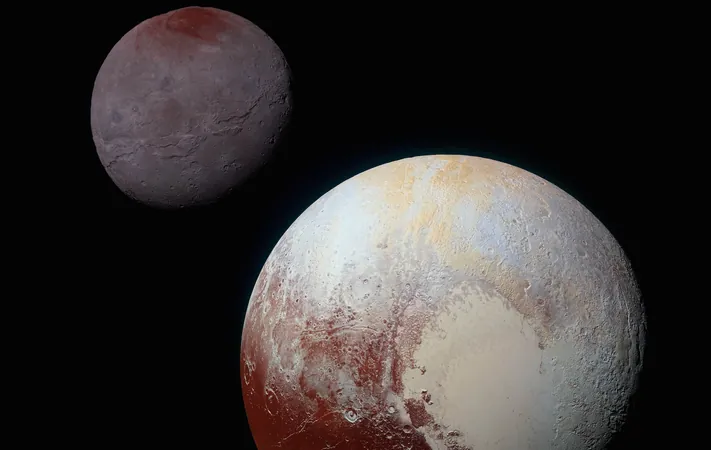
Unveiling the Cosmic Dance: Pluto and Charon's Intriguing Formation through "Kiss and Capture"
2025-01-07
Author: Siti
Introduction
In the chilly, distant realms of the Kuiper Belt, the enigmatic relationship between Pluto, a dwarf planet, and its unusually large moon, Charon, continues to perplex astronomers. For decades, the origins of this celestial duo have sparked intense debate among scientists. However, groundbreaking research from the University of Arizona has emerged, shedding light on their formation in a stunningly unconventional way: through a process dubbed "kiss and capture."
Historical Theories
Historically, the prevailing theory suggested that Pluto and Charon were born from a massive collision, similar to the violent birth of Earth's Moon. But researchers at the University of Arizona’s Lunar and Planetary Laboratory have found significant flaws with this theory. The icy and rocky natures of Pluto and Charon are starkly different from the molten materials involved in Earth’s lunar formation following a cataclysmic impact.
The Kiss and Capture Theory
Instead of a catastrophic collision scattering debris across space, the researchers propose that Pluto and Charon collided in a manner that allowed them to briefly connect before drifting apart, ultimately resulting in their unique binary system. This delicate balance of forces enabled them to become gravitationally bound, paving the way for their enduring cosmic partnership.
Key Findings
The key to this surprising "kiss and capture" scenario lies in the material characteristics of icy and rocky bodies. During their interaction, Pluto and proto-Charon avoided the extreme deformation typical of massive planetary collisions. As they collided, they formed a snowman-like structure, spinning together momentarily before separation. Computer simulations conducted by the team revealed that this particular interaction naturally evolved into a stable binary system.
Research Insights
Lead researcher Adeene Denton emphasized this astonishing revelation, saying, "When we accounted for the actual strength of these materials, we discovered something entirely unexpected. Most planetary collision models are categorized as 'hit and run' or 'graze and merge,' but we've identified a 'kiss and capture' scenario that keeps them bound."
Implications for Charon's Formation
Not only did the simulations delineate the "kiss and capture" process, but they also illuminated how Charon was formed and clarified its current orbital dynamics around Pluto. Senior study author Erik Asphaug noted the dual significance of their findings, stating, "The compelling aspect of this study is that the model parameters that successfully capture Charon also establish its correct orbit—a double success for our analysis."
Heating Effects
While Pluto and Charon remained largely intact during this cosmic encounter, the energy generated by the collision likely heated both bodies internally. This heating effect may have partially melted Pluto’s interior, leading to the formation of a subsurface ocean beneath its icy crust. Additionally, the gravitational forces exerted during their close interaction could have induced further heating, which may explain some of the striking geological features observed on their surfaces today. Charon's extensive fractures and Pluto's varied terrain might indeed reflect these early forces at play.
Broader Implications
This fascinating discovery could also shed light on the formation of other binary systems scattered across the Kuiper Belt, such as Eris and Dysnomia or Orcus and Vanth, suggesting that they may have followed similar "kiss and capture" processes. The study highlights how the peculiar conditions prevailing in the outer solar system—marked by frigid temperatures, low gravity, and icy compositions—lead to formation mechanisms that diverge from those of bodies situated closer to the Sun.
Future Research Directions
Encouraged by their findings, researchers are now broadening their simulations to investigate additional binary systems while exploring the long-term evolutionary trajectories of Pluto and Charon. With hopes pinned on future exploratory missions to the Kuiper Belt, scientists anticipate gathering more data to refine these captivating models, unlocking further secrets in the cosmos.
Conclusion
Stay tuned as we uncover more about the mysteries of our solar system—who knows what other cosmic romances lie hidden among the stars?


 Brasil (PT)
Brasil (PT)
 Canada (EN)
Canada (EN)
 Chile (ES)
Chile (ES)
 Česko (CS)
Česko (CS)
 대한민국 (KO)
대한민국 (KO)
 España (ES)
España (ES)
 France (FR)
France (FR)
 Hong Kong (EN)
Hong Kong (EN)
 Italia (IT)
Italia (IT)
 日本 (JA)
日本 (JA)
 Magyarország (HU)
Magyarország (HU)
 Norge (NO)
Norge (NO)
 Polska (PL)
Polska (PL)
 Schweiz (DE)
Schweiz (DE)
 Singapore (EN)
Singapore (EN)
 Sverige (SV)
Sverige (SV)
 Suomi (FI)
Suomi (FI)
 Türkiye (TR)
Türkiye (TR)
 الإمارات العربية المتحدة (AR)
الإمارات العربية المتحدة (AR)